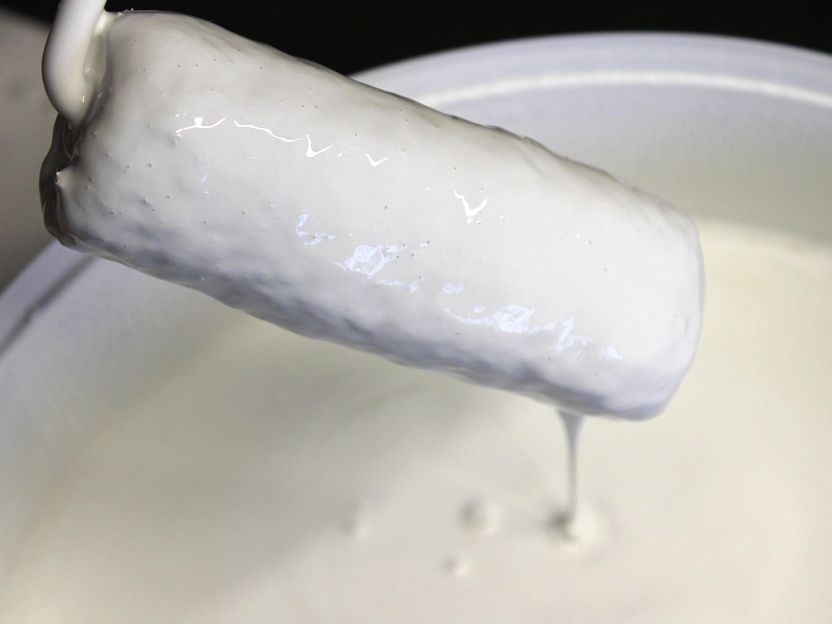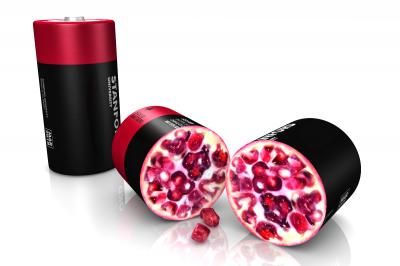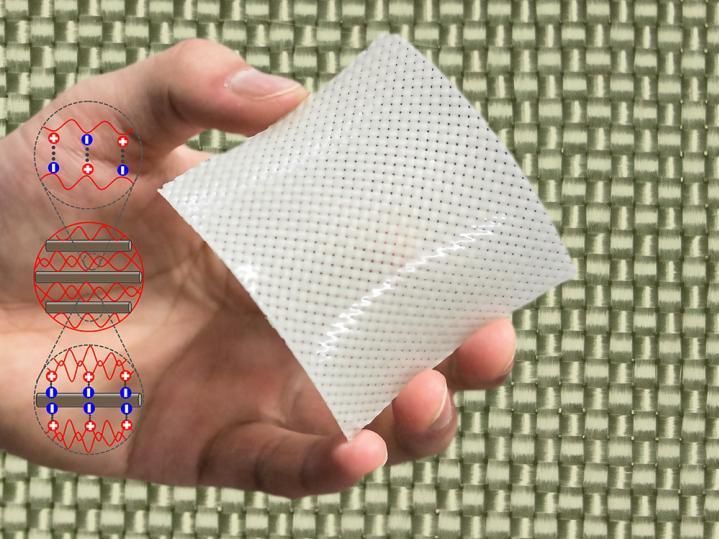Particles from everyday wall paints can harm living organisms
Novel membrane shows high filtering effects
Advertisement
dispersion paints are mostly used in households for painting walls and ceilings. An interdisciplinary research team from the University of Bayreuth has now analysed the chemical composition of two typical dispersion paints and discovered a large number of solid particles in them which are only a few micro- or nanometers in size. Studies on biological test systems showed that these particles can harm living organisms. Using a novel membrane developed at the University of Bayreuth, these particles can be filtered out of water before they enter the environment.

Dispersion paint, as it is frequently used in households.
UBT / Christian Wißler
Ingredients of dispersion paints
The Bayreuth study on the ingredients of dispersion paints and their possible effects on living organisms has been published in the journal "Ecotoxicology and Environmental Safety". It is based on close interdisciplinary networking in Collaborative Research Center 1357 "Microplastics" at the University of Bayreuth. The scientists selected two commercially available dispersion paints that are frequently used in households. These differ primarily in their dripping properties, because they were developed for wall painting on the one hand and ceiling painting on the other. The two paints have a solids content of 49 and 21 percent by weight, respectively, while the organic content is 57 and seven percent by weight. Characteristic solid components in the micro- or nanometer range are particles of silicon dioxide, titanium dioxide and calcium carbonate, as well as particles of various kinds of plastic, especially polyacrylate.
"Many of these tiny particles enter the environment, for example, through abrasion of the paint layers or weathering. Our study now shows that when brushes, rollers, scrapers and buckets used in painting walls and ceilings are cleaned by washing out paint residues, the particles from the dispersion paints can end up in wastewater and thus also in the environment. The impact on the environment needs to be thoroughly investigated, which is all the more urgent given the worldwide spread of dispersion paints and their diverse material compositions. That is why we have not limited ourselves to the chemical analysis of paint components, but have also investigated their effects on living organisms and cells," says Prof. Dr. Andreas Greiner, deputy spokesman of the Collaborative Research Center "Microplastics".
Effects on living organisms
For their inquiries, the Bayreuth scientists selected two test systems which have been well established in research: water fleas of the species Daphnia magna and a line of mouse cells. The water fleas were tested according to OECD guidelines for the testing of chemicals. In this test, the mobility of the organisms is considered. It was found that the mobility of the water fleas was significantly reduced when the water contained a high proportion of dissolved and undissolved inorganic nanoplastic and microplastic particles. In mouse cells, a decrease in cell activity was observed, which was generally caused by particles in the nanometer range. Metabolism in the mouse cells was significantly disrupted by nanoparticles of titanium dioxide and plastics in particular.
"Our research shows that the ingredients of dispersion paints can cause reactions of varying degrees in organisms and cells. Therefore, the possibility that the ingredients could be harmful to the environment cannot be ruled out. Further research in this area is urgently needed, especially since we still know far too little about whether interactions between nanoparticles made of plastic and inorganic nanoparticles can trigger additional damage," explains Prof. Dr. Christian Laforsch, spokesman for the Collaborative Research Center "Microplastics". "It is likewise still a largely unresolved question how the ingredients of dispersion paints interact with other substances in different environmental compartments – for example, in the air, in the soil or in rivers. However, it is already clear that dispersion paints should not be carelessly disposed of in the environment," says Prof. Dr. Ruth Freitag, who is Chair of Process Biotechnology at the University of Bayreuth.
A novel membrane with high filtering effects
Parallel to the studies of dispersion paints and their possible effects, researchers under the direction of Prof. Dr. Andreas Greiner have focussed on a further project: They have developed a new process to remove potentially harmful particles from dispersion wall paints from wastewater by filtration. This involves the use of a membrane made of functionalized fibers produced by the electrospinning process. The membrane retains micro- and nanometer-sized particles in different ways. On the one hand, the pores of the membrane are so fine that microparticles are not allowed to pass through. On the other hand, interactions between the membrane fibers and nanoparticles cause them to stick to the membrane surface even though they would fit into the pores. In both cases, the filtering effect is not associated with rapid and large-scale clogging of the pores. Therefore, water, for example, can easily pass through the membrane and run off.
In the journal "Macromolecular Materials and Engineering", the Bayreuth scientists describe the successful application of the membrane. They also tested the two dispersion paints that had proved potentially harmful to living organisms in the study. As it turned out, the membrane is able to retain typical colour components – in particular nanoparticles of titanium dioxide and polyacrylate, and microparticles of calcium carbonate. "In everyday life, all these colour components are discharged together into the wastewater. Here they mix and in some cases even change their structures and properties due to their interactions. Therefore, we specifically tested the filtration performance of our electrospun membrane on such mixtures. The high filtering effects we have achieved show that this process has great potential when it comes to purifying water from particles in the micro and nanometer range, such as those contained in commonly used paints around the world," says Greiner.
Original publication
Ann-Kathrin Müller, Julian Brehm, Matthias Völkl, Valérie Jérôme, Christian Laforsch, Ruth Freitag, Andreas Greiner: Disentangling biological effects of primary nanoplastics from dispersion paints’ additional compounds. Ecotoxicology and Environmental Safety (2022).
Ann-Kathrin Müller, Zhi-Kang Xu, Andreas Greiner: Filtration of Paint-Contaminated Water by Electrospun Membranes. Macromolecular Materials and Engineering (2022).
























































